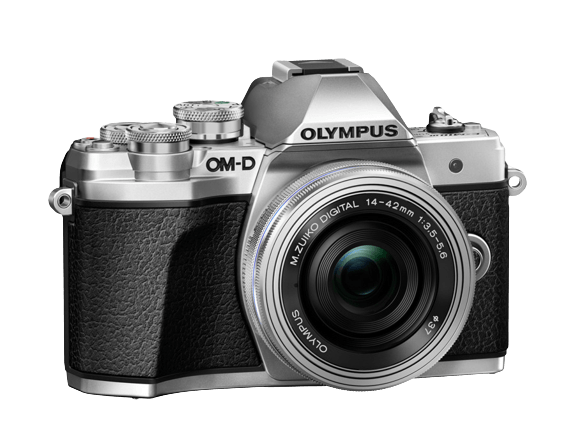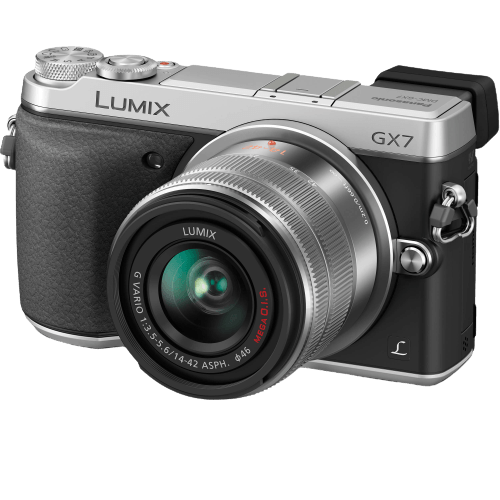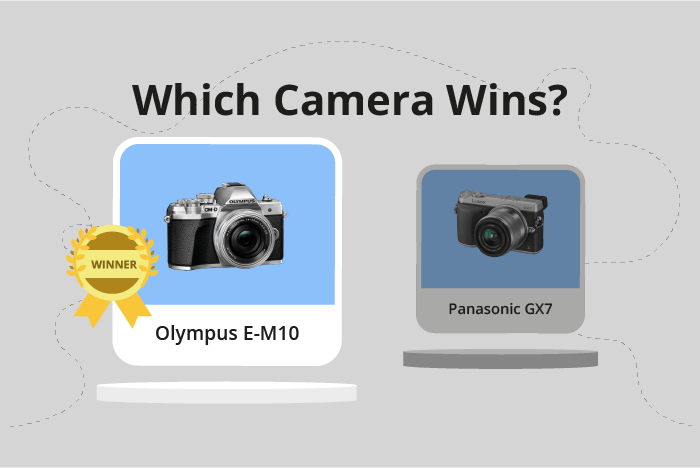Olympus OM-D E-M10 vs Panasonic Lumix DMC-GX7 Comparison
Olympus OM-D E-M10

Panasonic Lumix DMC-GX7

The Olympus OM-D E-M10 outperforms the Panasonic Lumix DMC-GX7 with a score of 54/100 compared to 52/100. Both cameras are mirrorless and were released in 2014 and 2013, respectively. They share similarities in size and weight, with the E-M10 measuring 119 x 82 x 46mm and weighing 396g, while the GX7 is 123 x 71 x 55mm and weighs 402g.
The E-M10 has an advantage with a lower launch price of $700 compared to the GX7 at $999. This makes the E-M10 more affordable without compromising on quality. However, the GX7 has its merits with a slightly more compact design, which may be appealing to some users.
Taking these factors into consideration, the Olympus OM-D E-M10 emerges as the better option due to its higher score, lower launch price, and comparable specifications. While the Panasonic Lumix DMC-GX7 is a decent camera, its higher price and lower score make it less attractive.
Olympus OM-D E-M10 vs Panasonic Lumix DMC-GX7 Overview and Optics
The Olympus OM-D E-M10 triumphs over the Panasonic Lumix DMC-GX7 in optics, with a score of 57/100 to 54/100. Both cameras share several specifications, including a 16-megapixel CMOS sensor, Micro Four Thirds sensor size, Micro 4/3 lens mount, and image stabilization. These common features make for a close competition between the two models.
The OM-D E-M10 outperforms the GX7 in several aspects. With 16.1 megapixels compared to the GX7’s 16 megapixels, the E-M10 has a slight advantage in image resolution. The E-M10’s shooting speed of 8 frames per second surpasses the GX7’s slower 5 frames per second, allowing for better capture of fast-moving subjects. Additionally, the E-M10’s TruePic VII processor and DXOMARK sensor score of 72 contribute to its superior image quality compared to the GX7’s Venus Engine processor and DXOMARK score of 70.
Despite its lower overall score, the Panasonic Lumix DMC-GX7 does have some advantages. Its image stabilization system is renowned for its effectiveness in reducing camera shake and ensuring sharp images. This feature, although also present in the E-M10, is particularly noteworthy in the GX7.
Taking these factors into consideration, the Olympus OM-D E-M10 offers better optics due to its higher resolution, faster shooting speed, and superior processor and sensor. However, the Panasonic Lumix DMC-GX7 should not be overlooked, as its effective image stabilization system can be beneficial for photographers who prioritize steady shots.
Olympus OM-D E-M10 vs Panasonic Lumix DMC-GX7 Video Performance
The Olympus OM-D E-M10 emerges as the winner in video capabilities with a score of 57/100, slightly edging out the Panasonic Lumix DMC-GX7, which scored 56/100. Both cameras share some common video specifications, such as Full HD maximum video resolution and maximum video dimensions of 1920 x 1080.
The OM-D E-M10 outperforms the Lumix DMC-GX7 in one key area: it has built-in time-lapse functionality. This feature allows users to create stunning time-lapse videos without the need for additional software or equipment. This advantage makes the E-M10 a more versatile and convenient choice for those interested in capturing time-lapse footage.
On the other hand, the Lumix DMC-GX7 excels in its maximum video frame rate, which is 60fps, compared to the 30fps offered by the E-M10. A higher frame rate results in smoother video playback, especially for fast-moving scenes or action shots. This advantage could make the DMC-GX7 more appealing to users who prioritize smooth video quality.
Considering these points, the Olympus OM-D E-M10 is a better choice for users who value the convenience of built-in time-lapse functionality. Meanwhile, the Panasonic Lumix DMC-GX7 may be more suitable for those who prioritize smooth video playback through a higher frame rate. Despite the slight difference in scores, both cameras offer solid video capabilities, and the choice ultimately depends on the user’s specific needs and preferences.
Olympus OM-D E-M10 vs Panasonic Lumix DMC-GX7 Features and Benefits
The Olympus OM-D E-M10 and Panasonic Lumix DMC-GX7 both have a feature score of 57/100, making them equal in this aspect of comparison. They share several common specifications, including a 3-inch screen size, the absence of GPS and Bluetooth, and the presence of a touchscreen, flip screen, and Wi-Fi connectivity.
The Olympus OM-D E-M10 has a screen resolution of 1,037,000 dots, which is slightly lower than the Panasonic Lumix DMC-GX7’s 1,040,000 dots. Despite this minor difference, the E-M10 does not fall behind in terms of screen quality and resolution.
On the other hand, the Panasonic Lumix DMC-GX7 has a marginally higher screen resolution, providing a slightly clearer and sharper display. This advantage, however, is not substantial enough to declare the GX7 as a significantly better camera in terms of features.
Both cameras excel in their respective ways, with neither having a clear advantage over the other in terms of features. The Olympus OM-D E-M10 and Panasonic Lumix DMC-GX7 are equally capable, offering users a similar set of features and specifications. The minor differences in screen resolution do not create a significant impact on the overall performance and quality of the cameras. Ultimately, the choice between the two cameras will depend on personal preferences and specific requirements of the user.
Olympus OM-D E-M10 vs Panasonic Lumix DMC-GX7 Storage and Battery
The Olympus OM-D E-M10 and the Panasonic Lumix DMC-GX7 both have a storage and battery score of 21/100. These cameras share common specifications in terms of storage, as they both have one memory card slot and accept SD, SDHC, and SDXC memory cards.
When it comes to battery life, the Panasonic Lumix DMC-GX7 takes the lead, offering 350 shots compared to the Olympus OM-D E-M10’s 320 shots. The battery type for the Lumix DMC-GX7 is Li-Ion, 7.2V, 1200 mAh, while the OM-D E-M10 uses a BLS-5 battery.
However, neither camera supports USB charging.
Considering the storage and battery aspects, the Panasonic Lumix DMC-GX7 has a slight advantage due to its longer battery life. Despite this, both cameras have similar storage capabilities, making them suitable choices for various photography needs.
Olympus OM-D E-M10 vs Panasonic Lumix DMC-GX7 – Our Verdict
Are you still undecided about which camera is right for you? Have a look at these popular comparisons that feature the Olympus OM-D E-M10 or the Panasonic Lumix DMC-GX7:

